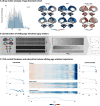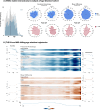This is a preprint.
A WORLDWIDE ENIGMA STUDY ON EPILEPSY-RELATED GRAY AND WHITE MATTER COMPROMISE ACROSS THE ADULT LIFESPAN
- PMID: 38496668
- PMCID: PMC10942350
- DOI: 10.1101/2024.03.02.583073
A WORLDWIDE ENIGMA STUDY ON EPILEPSY-RELATED GRAY AND WHITE MATTER COMPROMISE ACROSS THE ADULT LIFESPAN
Abstract
Objectives: Temporal lobe epilepsy (TLE) is commonly associated with mesiotemporal pathology and widespread alterations of grey and white matter structures. Evidence supports a progressive condition although the temporal evolution of TLE is poorly defined. This ENIGMA-Epilepsy study utilized multimodal magnetic resonance imaging (MRI) data to investigate structural alterations in TLE patients across the adult lifespan. We charted both grey and white matter changes and explored the covariance of age-related alterations in both compartments.
Methods: We studied 769 TLE patients and 885 healthy controls across an age range of 17-73 years, from multiple international sites. To assess potentially non-linear lifespan changes in TLE, we harmonized data and combined median split assessments with cross-sectional sliding window analyses of grey and white matter age-related changes. Covariance analyses examined the coupling of grey and white matter lifespan curves.
Results: In TLE, age was associated with a robust grey matter thickness/volume decline across a broad cortico-subcortical territory, extending beyond the mesiotemporal disease epicentre. White matter changes were also widespread across multiple tracts with peak effects in temporo-limbic fibers. While changes spanned the adult time window, changes accelerated in cortical thickness, subcortical volume, and fractional anisotropy (all decreased), and mean diffusivity (increased) after age 55 years. Covariance analyses revealed strong limbic associations between white matter tracts and subcortical structures with cortical regions.
Conclusions: This study highlights the profound impact of TLE on lifespan changes in grey and white matter structures, with an acceleration of aging-related processes in later decades of life. Our findings motivate future longitudinal studies across the lifespan and emphasize the importance of prompt diagnosis as well as intervention in patients.
Keywords: Epilepsy; aging; atrophy; lifespan; multimodal; temporal lobe epilepsy.
Figures



Similar articles
-
Changes in Gray Matter Morphology and White Matter Microstructure Across the Adult Lifespan in People With Temporal Lobe Epilepsy.Neurology. 2025 Sep 23;105(6):e213688. doi: 10.1212/WNL.0000000000213688. Epub 2025 Aug 22. Neurology. 2025. PMID: 40845263
-
Spatial patterns of gray and white matter compromise relate to age of seizure onset in temporal lobe epilepsy.Neuroimage Clin. 2023;39:103473. doi: 10.1016/j.nicl.2023.103473. Epub 2023 Jul 8. Neuroimage Clin. 2023. PMID: 37531834 Free PMC article.
-
Associations of Cerebral Blood Flow Patterns With Gray and White Matter Structure in Patients With Temporal Lobe Epilepsy.Neurology. 2024 Aug 13;103(3):e209528. doi: 10.1212/WNL.0000000000209528. Epub 2024 Jul 15. Neurology. 2024. PMID: 39008785 Free PMC article.
-
Automated tractography in patients with temporal lobe epilepsy using TRActs Constrained by UnderLying Anatomy (TRACULA).Neuroimage Clin. 2017 Jan 5;14:67-76. doi: 10.1016/j.nicl.2017.01.003. eCollection 2017. Neuroimage Clin. 2017. PMID: 28138428 Free PMC article.
-
The superficial white matter in temporal lobe epilepsy: a key link between structural and functional network disruptions.Brain. 2016 Sep;139(Pt 9):2431-40. doi: 10.1093/brain/aww167. Epub 2016 Jun 29. Brain. 2016. PMID: 27357350 Free PMC article.
References
-
- Wiebe S, Blume WT, Girvin JP, Eliasziw M. A randomized, controlled trial of surgery for temporal-lobe epilepsy. N Engl J Med. 2001;345(5):311–318. - PubMed
-
- Bernhardt BC, Bonilha L, Gross DW. Network analysis for a network disorder: The emerging role of graph theory in the study of epilepsy. Epilepsy Behav. 2015;50:162–170. - PubMed
Publication types
Grants and funding
LinkOut - more resources
Full Text Sources
Miscellaneous
